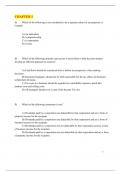CHAPTER 1
1) Which of the following is not considered to be a separate entity for tax purposes in
Canada?
M
A) An individual
B) A proprietorship
ED
C) A corporation
D) A trust
C
2) Which of the following attitudes and actions is most likely to help decision-makers
develop an efficient approach to taxation?
O
A) Cash flows should be considered from a before-tax perspective when making
N
decisions.
B) Functional managers should not be held responsible for the tax effects of decisions
within their divisions.
N
C) Tax costs to a business should be regarded as controllable expenses, much like
product costs and selling costs.
D) All managers should own a copy of the Income Tax Act.
O
IS
3) Which of the following statements is true?
SE
A) Dividends paid by a corporation are deductible by that corporation and are a form of
property income for the recipient.
B) Dividends paid by a corporation are deductible by that corporation and are a form of
business income for the recipient.
U
C) Dividends paid by a corporation are not deductible by that corporation and are a form
of business income for the recipient.
D) Dividends paid by a corporation are not deductible by that corporation and are a form
R
of property income for the recipient.
1
, 4) When assessing the value of a corporation, the most relevant information that decision-
makers normally consider is
M
A) the potential for before-tax profits.
B) the potential for after-tax profits.
ED
C) the current corporate tax rate.
D) cash flow before-tax.
C
5) Two investor corporations may not enter jointly into which of the following?
O
A) Joint venture
B) Partnership
N
C) Separate corporation
D) Proprietorship
N
O
6) Income tax is calculated for which of the following jurisdictional groups?
IS
A) Municipal, provincial, and federal
B) Municipal, federal, and foreign
C) Provincial, federal, and foreign
SE
D) Municipal, provincial, and foreign
U
7) Which of the following statements is true?
R
2
, A) Cash flow should never be calculated on an after-tax basis.
B) The tax cost to a business should be regarded as a cost of doing business.
C) Income tax cannot be treated as a controllable cost.
D) The value of an enterprise should be based on pre-tax cash flow.
M
ED
8) Logan holds a 7% interest-bearing debt instrument in Glow Co. Glow Co.'s tax rate is
27%, and Logan is in a 45% tax bracket. Which of the following statements is correct?
A) The after-tax cost of the debt instrument is 5.11% to Glow Co., and the after-tax value
C
to Logan is 3.85%.
B) The after-tax cost of the debt instrument is 5.11% to Glow Co., and the after-tax value
O
to Logan is 3.15%.
C) The after-tax cost of the debt instrument is 1.89% to Glow Co., and the after-tax value
to Logan is 3.15%.
N
D) The after-tax cost of the debt instrument is 7% to Glow Co., and the after-tax value to
Logan is 7%.
N
O
9) Which of the following lists accurately names the five general income categories for tax
purposes?
IS
A) Business, Interest, Employment, Capital Gains, Other
B) Business, Property, Employment, Capital Gains, Foreign
SE
C) Business, Property, Employment, Capital Gains, Other
D) Business, Property, Employment, Investments, Other
U
10) Proprietorships, corporations, partnerships, limited partnerships, joint ventures, and
income trusts are all
R
3
, A) categories of income for tax purposes.
B) tax jurisdictions.
C) examples of financial instruments.
D) forms of business.
M
ED
11) Which of the following statements regarding taxation within jurisdictions in Canada is
true?
A) Federal and provincial or territorial tax brackets are always identical to one another.
C
B) Only federal taxes apply to individuals while both federal and provincial or territorial
taxes apply to corporations.
O
C) Both federal and provincial or territorial taxes apply to Canadian taxpayers.
D) Only federal taxes apply to corporations while both federal and provincial taxes apply
to individuals.
N
N
12) Jamie is an employee at ABC Ltd. and is in a 45% tax bracket. ABC Ltd. has a tax rate of
27%. The company has offered Jamie a 10% pay raise. Jamie's current salary is $50,000. What is
O
after-tax cost of the raise to ABC Ltd.?
IS
A) $1,350
B) $2,750
C) $2,858
SE
D) $3,650
U
13) Simone is an employee at XYZ Ltd. and is in a 45% tax bracket. XYZ Ltd. has a tax rate
of 27%. The company has offered Simone a 10% pay raise. Simone's current salary is $50,000.
What is after-tax value of the raise to Simone?
R
4




